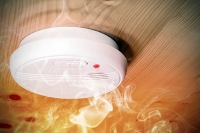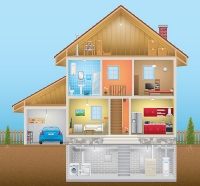Healthy Homes - Carbon Monoxide

What is carbon monoxide?
What are some common sources of carbon monoxide?
Who is at risk from carbon monoxide poisoning?
How are people exposed to carbon monoxide?
What are the symptoms of carbon monoxide poisoning?
What should be done if someone may have carbon monoxide poisoning?
Should a carbon monoxide detector be installed in my home?
How do I prevent carbon monoxide poisoning during a power outage?
How can I prevent carbon monoxide poisoning from vehicles and other equipment?
How can I prevent carbon monoxide poisoning from my home appliances?
Can a medical test determine exposure to carbon monoxide?
Additional resources
What is carbon monoxide?
Carbon monoxide, or CO, is a poisonous gas that cannot be smelled, seen or tasted, and can cause death in minutes if it is at high levels. Carbon monoxide can quickly build up to unsafe levels in enclosed or semi-enclosed areas.
What are some common sources of carbon monoxide?
Carbon monoxide is produced when fuel is not completely burned in:
- Gas furnaces
- Cars, trucks, boats and other vehicles
- Small gasoline-powered equipment like generators, weed trimmers and chain saws
- Gas stoves
- Lanterns
- Burning charcoal and wood
- Any heating system or appliance that burns gas, oil, wood, gasoline, propane or kerosene
Tobacco smoke is a significant source of carbon monoxide in homes with smokers. Roughly 50 percent of all carbon monoxide poisonings occur in the home, 40 percent are automobile related and 10 percent occur in work settings.
Who is at risk from carbon monoxide poisoning?
All people and animals are at risk for carbon monoxide poisoning. Certain groups are more easily affected by carbon monoxide poisoning:
- Unborn babies
- Infants
- Children
- Pregnant women
- People with chronic heart disease, anemia or respiratory problems
- People who already have elevated carbon monoxide blood levels, such as smokers
How are people exposed to carbon monoxide?
People may be exposed to unsafe levels of carbon monoxide when charcoal, natural gas, gasoline, other fuel oils or wood are burned in a poorly ventilated area. Breathing automobile exhaust in a confined area can also result in carbon monoxide exposure. Enclosed garages can quickly fill with carbon monoxide if automobiles are left idling inside.
What are the symptoms of carbon monoxide poisoning?
Common symptoms are:
- Headache
- Dizziness
- Fatigue
- Nausea
- Vomiting
- Shortness of breath
- Chest pain
- Weakness
- Confusion
Breathing high levels of carbon monoxide can cause loss of consciousness and death. People who are sleeping can die from carbon monoxide poisoning before ever knowing they are being exposed to the gas.
What should be done if you suspect someone has carbon monoxide poisoning?
- Immediately go outside to get fresh air. Call 911.
- If someone is unconscious and cannot leave, open windows and doors to bring in fresh air. Turn off the source of carbon monoxide. Call 911.
Should a carbon monoxide detector be installed in my home?
Yes, these detectors are similar to smoke alarms and can warn you when carbon monoxide levels become unsafe. If the alarm goes off, evacuate the building and call 911. Follow the carbon monoxide detector instructions for routine maintenance, including regular replacement of batteries. If the carbon monoxide detector is wired to the electrical supply, make sure it has back-up batteries for when the electricity is off.
How do I prevent carbon monoxide poisoning during a power outage?
- Never use a charcoal or gas grill in an enclosed space, such as inside your home, garage or in a tent or camper.
- Do not burn charcoal in your fireplace. A charcoal fire will not create a chimney draft strong enough to push the carbon monoxide to the outside.
- Never use a generator inside your home, garage, carport, basement, crawlspace or near an outside window, door or vent. Generators should be at least 20 feet away from buildings. Even at 20 feet away, air flow patterns could still blow carbon monoxide into your home through attic vents, windows or doors, so it's very important to have a working carbon monoxide detector inside the home.
- Never use a gas range or gas oven to heat your home.
- Never sleep in a room while using an unvented gas or kerosene heater.
How can I prevent carbon monoxide poisoning from vehicles and other equipment?
- Never run a vehicle in a garage, even when the garage door is open.
- Never use gasoline powered equipment, including generators, indoors or in poorly ventilated areas.
- Have a mechanic check the exhaust system of your car every year. A small leak in your car's exhaust system can lead to a build-up of carbon monoxide inside the car.
- Don't allow people to travel inside truck canopies and campers. Vehicle exhaust can be drawn into the covered or enclosed area of canopies and campers.
- Boaters should be aware of exhaust "back drafting" into the boat's cabin, cockpit or deck. Make sure people swim and play away from the engine exhaust of the boat.
How can I prevent carbon monoxide poisoning from my home appliances?
- Have propane, kerosene and gas appliances and fireplaces, as well as wood stoves, checked every year by a trained professional.
- Make sure chimneys and flues are routinely checked and cleaned. Never burn anything in a stove or fireplace that is not vented.
- Do not use unvented gasoline, propane, kerosene or other fuel heaters.
- If you suspect you have been exposed to carbon monoxide, leave your home immediately, call 911.
- Don't go back into the home until the problem has been resolved.
Can a medical test determine exposure to carbon monoxide?
Carbon monoxide is eliminated from the body over a period of hours. Although carbon monoxide levels can be measured in exhaled breath, urine, blood and other tissues, there is not a reliable method to determine the level of your exposure. If you suspect carbon monoxide exposure, take immediate action. Call your local fire department and move everyone outdoors into fresh air. Seek medical advice if you have any symptoms that you think may be related to chemical exposure.

Additional resources
Tennessee Poison Center 1-800-222-1222
https://www.vumc.org/poison-control/home
Poison Control Center 1-800-222-1222
www.aapcc.org
U.S. Environmental Protection Agency (EPA)
Carbon Monoxide
www.epa.gov/co-pollution
Centers for Disease Control and Prevention (CDC)
Carbon Monoxide
www.cdc.gov/co
Consumer Product Safety Commission (CPSC)
Carbon Monoxide Info Center
http://www.cpsc.gov/en/Safety-Education/Safety-Education-Centers/Carbon-Monoxide-Information-Center
Tennessee Department of Health (TDH)
Carbon Monoxide Poisoning Prevention Checklist
English Spanish